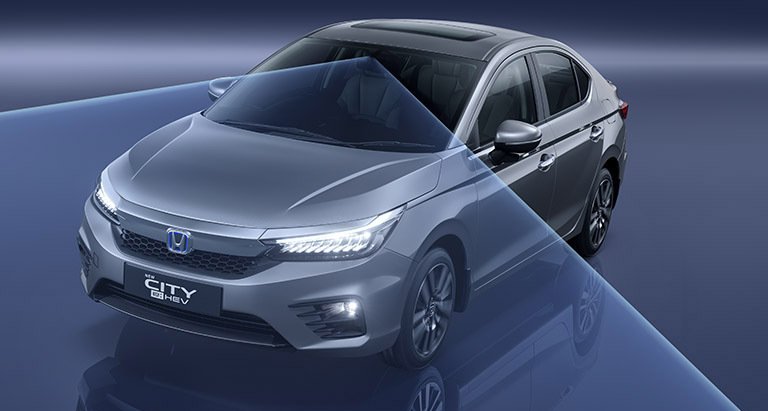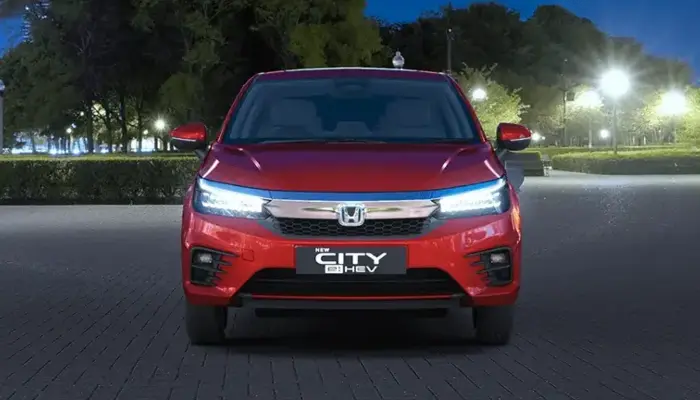
The Honda City has gained a cult status in the Indian car market as a premium and aspirational sedan for the masses. The car started as a petrol-only model with its first-generation version, while it gained the option of a diesel powertrain in the fourth-generation model. Currently, the Honda City is enjoying strong numbers and is instrumental in keeping the demand for sedans alive in India.
To ensure that the craze for sedans doesn’t fizzle out completely, Honda has now introduced a new version of the City with a technically-advanced hybrid powertrain, which is a combination of a petrol engine with electric motors and a battery. Honda has already done something like this in the past with the Civic Hybrid and Accord Hybrid, though it aims to be successful in the mass market this time with the City Hybrid.
Here’s our comprehensive comparison of the petrol, diesel and full-hybrid versions of the fifth-generation Honda City currently on sale, which will let you know which version out of the three is more suitable for you.
Price and Variant

While the petrol and diesel versions of the Honda City are available in three variants – V, VX and ZX, the Honda City e:HEV Hybrid is available only in a single top-spec ZX variant. The Honda City e:HEV Hybrid is available at a price which carries a premium of more than Rs 4 lakh over the top-spec variants of the petrol and diesel versions of the same car.
| Variant |
Honda City petrol-manual |
Honda City petrol-CVT |
Honda City diesel-manual |
Honda City e:HEV hybrid |
| V |
Rs 11.29 lakh |
Rs 12.69 lakh |
Rs 12.89 lakh |
Not available |
| VX |
Rs 12.75 lakh |
Rs 14.05 lakh |
Rs 14.25 lakh |
Not available |
| ZX |
Rs 13.74 lakh |
Rs 15.04 lakh |
Rs 15.24 lakh |
Rs 19.50 lakh |
ALSO READ: 2022 Maruti Suzuki XL6 Zeta vs Alpha vs Alpha Plus Variants Compared
Engine and Performance

Compared to the conventional 1.5-litre four-cylinder petrol and diesel engines in the IC-engine versions of the Honda City, the e:HEV Hybrid version gets a unique combination of a 1.5-litre Atkinson cycle petrol engine, which is assisted by two electric motors and a lithium-ion battery. Out of these two motors, one serves as a starter-generator, while the other serves as the main driving motor for the electric-only mode. The Honda City e:HEV Hybrid can be operated in three modes – electric-only, petrol-only and petrol-electric hybrid. It also gets a unique e-CVT transmission, which is very different from the 6-speed manual transmission in both the variants and even the CVT available as an option in the petrol version of the City.
| Specifications |
Honda City petrol |
Honda City diesel |
Honda City e:HEV hybrid |
| Engine |
1.5-litre four-cylinder naturally-aspirated petrol |
1.5-litre four-cylinder diesel |
1.5-litre four-cylinder naturally-aspirated Atkinson petrol + two electric motors and a lithium-ion battery |
| Maximum power |
121 PS @ 6,600 rpm |
100 PS @ 3,600 rpm |
Engine – 98 PS @ 5,600-6,400 rpm
Electric motor – 109 PS @ 3,500 rpm
Combined – 126 PS |
| Maximum torque |
145 Nm @ 4,300 rpm |
200 Nm @ 1,750 rpm |
Engine – 127 Nm @ 4,500-5,000 rpm
Electric motor – 253 Nm @ 0-3,000 rpm |
| Transmission |
6-speed MT / CVT |
6-speed manual |
e-CVT with engine-linked clutch |
| Fuel efficiency |
17.kmpl (manual) / 18.4 kmpl (CVT) |
24.1 kmpl |
26.5 kmpl |
ALSO READ: 2022 Kia Sonet Variants Explained Which One To Buy
Dimensions
All the three versions of the Honda City – petrol, diesel and full-hybrid – have the same length, width, height, wheelbase, turning radius and fuel tank capacity. The City Hybrid is the heaviest of the three, due to the presence of a heavy battery pack at the back. This battery pack also eats a significant amount of boot space, as the Hybrid has a boot space of 306 litres against the 506 litres boot space of the other two versions.
| Dimensions |
Honda City petrol |
Honda City diesel |
Honda City e:HEV hybrid |
| Length |
4,549 mm |
4,549 mm |
4,549 mm |
| Width |
1,748 mm |
1,748 mm |
1,748 mm |
| Height |
1,489 mm |
1,489 mm |
1,489 mm |
| Wheelbase |
2,600 mm |
2,600 mm |
2,600 mm |
| Turning radius |
5.3 m |
5.3 m |
5.3 m |
| Kerb weight |
1,107 kg (manual) / 1,153 kg (CVT) |
1,217 kg |
1,280 kg |
| Boot space |
506 litres |
506 litres |
306 litres |
| Fuel tank capacity |
40 litres |
40 litres |
40 litres |
Design
On the outside, all three versions have the same design, which looks the same from a distance. The Honda City, in all these three iterations gets a huge slab of chrome for the front grille, full-LED headlamps with daytime running LEDs and LED turn indicators, LED fog lamps, and 16-inch diamond-cut alloy wheels and LED tail lamps.
It is only a closer inspection which reveals the minute visual changes introduced in the e:HEV Hybrid version. The changes include different honeycomb mesh patterns for the grille, claw-shaped housings for fog lamps, blue highlights around the Honda logo at front and rear, a different dual-tone design for the diamond-cut alloy wheels and a slim spoiler on the boot lid.
Interior and Features

On the inside too, there is not much to differentiate between the three versions of the Honda City. The petrol, diesel and e:HEV Hybrid versions of the Honda City get the same dual-tone black and beige leather upholstery with faux wood and silver inserts on the dashboard and door panels.
The cabin of all the three versions of the Honda City is bestowed with features like an 8-inch touchscreen infotainment system with Apple Carplay and Android Auto, TFT instrument console, automatic climate control, driver seat height adjustment, sunroof, tilt and telescopic adjustable steering wheel with audio, Bluetooth and cruise control buttons, push start-stop button and rear AC vents. The Honda City e:HEV Hybrid gets revised display modes for the instrument console while featuring different types of gauges indicating the functioning of the hybrid powertrain.
All the versions here come with front, side and curtain airbags, ABS with EBD, reverse parking sensors, 180-degree multi-angle reverse camera, lane watch camera, brake assist, vehicle stability assist, traction control, agile handling assist, hill start assist, tyre pressure monitoring system and ISOFIX mounts for child seats.
The Honda City e:HEV Hybrid also gains an upper hand, when it comes to safety features. The e:HEV Hybrid version, in addition to all these features, exclusively gets ‘Honda Sensing’ suite of autonomous driving assistance systems, such as collision mitigation braking, road departure mitigation, lane keep assist, adaptive cruise control and auto high beam for headlamps. It also gets rear disc brakes and a frameless design for the auto-dimming inside rearview mirror, both of which are not available in the petrol and diesel versions of the City.
Verdict
While the Honda City e:HEV Hybrid version is the most advanced of the trio here, the premium of over Rs 4 lakh is a deep stretch for a lot of buyers, especially the common mass-market buyers. This wide price gap makes the Honda City Hybrid appealable to only those who value modern technology or want an exceptional fuel economy with a petrol-powered engine. Apart from these advantages, the regular petrol and diesel versions of the City should suffice with most of the buyers, thus making the City Hybrid a niche offering to go for.
ALSO READ: 2022 MG ZS EV vs Tata Nexon EV
You must be logged in to post a comment Login